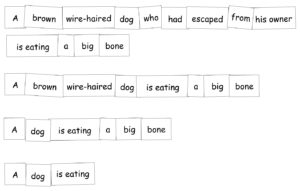The expansion exercise aims to further elaborate a sentence by adding additional elements (adjectives, phrases, clauses) to it. For example: “The woman sings” → “The young, well-dressed woman, who studied voice in Rome to become a professional singer, sings beautiful songs in the fabulously decorated concert hall”. The opposite occurs when condensing texts, i. e., stripping sentences to their essential core. Example: “A brown, wire-haired dog, who had escaped from its owner, is eating a big bone” → “A dog is eating”.

By working with expanding and condensing texts in a playful manner, students develop a “feel“ for the possibilities of experimenting with language and style at the sentence level.
Variants:
- The instructor first goes through one or several examples with the class or group. Then, each student (or pair) receives a short sentence and some strips of paper with the instruction to expand on it and write the longest possible sentence. (expansion probe).
- The students are then given a short sentence, such as “the dog is barking.” They must add an element to the sentence (adjective, phrases, etc.), such as: “the hungry dog is barking”, “the hungry dog is barking all day long”, “the hungry dog is barking all day long because he has no food” etc. This would be practiced orally and then in written form.
- Sentences from stories, etc., may also be chosen for the condensing exercise, whereby all non-essential elements are being omitted.
- The expansion exercise can be used to create an entire text consisting of only short sentences. Task: increase the length of the text to at least twice the original length.






